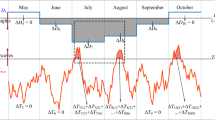Abstract
In this study, trends of combined climate indices based on daily mean temperatures and precipitation were analysed. The combined indices Cold/Dry (CD), Cold/Wet (CW), Warm/Dry (WD) and Warm/Wet (WW) days were examined during the period 1961–2010 at seven stations distributed across Serbia. Decreasing tendencies of CD and CW and increasing tendencies of WD were observed during the winter, spring and summer. It was found that trends of all combined indices were insignificant during the autumn. The most significant trends of CD and WD were revealed for the summer season. The results showed that a negative correlation existed between the East Atlantic pattern and CD and CW, but that a positive correlation existed for WD for all seasons. The North Atlantic Oscillation dominated during the winter, and the East Atlantic/West Russia pattern governed during the autumn.







Similar content being viewed by others
References
Alexander LV, Zhang X, Peterson TC et al (2006) Global observed changes in daily climate extremes of temperature and precipitation. J Geoph Res 111:D05109
Alexandersson H, Moberg A (1997) Homogenization of Swedish temperature data. Part I: homogeneity test for linear trends. Int J Climatol 17:25–34
Arsenović P, Tošić I, Unkašević M (2013) Seasonal analysis of warm days in Belgrade and Niš. J Geogr Institute Jovan Cvijić 63:1–10
Barnston AG, Livezey RE (1987) Classification, seasonality and persistence of low-frequency atmospheric circulation patterns. Mon Weather Rev 115:1083–1126
Beniston M (2009) Trends in joint quantiles of temperature and precipitation in Europe since 1901 and projected for 2100. Geophys Res Lett 36:L07707
Beniston M, Goyette S (2007) Changes in variability and persistence of climate in Switzerland; exploring 20th century observations and 21st century simulations. Global Planet Change 57:1–15
Beniston M, Uhlmann B, Goyette S, Lopez-Moreno JI (2011) Will snow-abundant winters still exist in the Swiss Alps in an enhanced greenhouse climate? Int J Climatol 31:1257–1263
Brown SJ, Caesar J, Ferro CAT (2008) Global changes in extreme daily temperature since 1950. J Geophys Res 113:1984–2012. doi:10.1029/2006JD008091
Brunetti M, Maugeri M, Monti F, Nanni T (2006) Temperature and precipitation variability in Italy in the last two centuries from homogenized time series. Int J Climatol 26:345–381
Frich P, Alexander LV, Della-Marta P, Gleason B, Haylock M, Klein Tank AMG, Peterson T (2002) Observed coherent changes in climatic extremes during the second half of the twentieth century. Clim Res 19:193–212
Gallant AJE, Karoly DJ (2010) A combined climate extremes index for the Australian region. J Clim 23:6153–6165
Hurrell JW (1995) Decadal trends in the North Atlantic Oscillation regional temperatures and precipitation. Science 269:676–679
IPCC (2007) Climate Change 2007: The Physical Basis. Contribution of Working Group I to the Fourth Assessment Report of the Intergovernmental Panel on Climate Change, edited by S. Solomon et al. Cambridge University Press, New York
Josey SA, Somot S, Tsimplis M (2011) Impacts of atmospheric modes of variability on Mediterranean Sea surface heat exchange. J Geophys Res 116:C02032. doi:10.1029/2010JC006685
Klein Tank AMG, Können GP (2003) Trends in indices of daily temperature and precipitation extremes in Europe 1946–99. J Clim 16:3665–3680
Knežević S, Tošić I, Unkašević M, Pejanović G (2014) The influence of the East Atlantic Oscillation to climate indices based on the daily minimum temperatures in Serbia. Theor Appl Climatol 116:435–446
Krichak SO, Alpert P (2005) Decadal trends in the east Atlantic-west Russia pattern and Mediterranean precipitation. Int J Climatol 25:183–192
Nastos P, Politi N, Kapsomenakis J (2013) Spatial and temporal variability of the Aridity Index in Greece. Atmos Res 119:140–152
Ozer P, Mahamoud A (2013) Recent extreme precipitation and temperature changes in Djibouti city (1966–2011). J Climatol (ID 928501)
Scaife AA, Folland CK, Alexander LV, Moberg A, Knight JR (2008) European climate extremes and the North Atlantic Oscillation. J Clim 21:22–39
Tebaldi C, Sansó B (2009) Joint projections of temperature and precipitation change from multiple climate models: a hierarchical Bayesian approach. J R Stat Soc Ser A (Stat Soc) 172:83–106
Tencer B, Weaver A, Zwiers F (2014) Joint occurrence of daily temperature and precipitation extreme events over Canada. J App Meteor Climatol 53:2148–2162. doi:10.1175/JAMC-D-13-0361.1
Tošić I (2004) Spatial and temporal variability of winter and summer precipitation over Serbia and Montenegro. Theor Appl Climatol 77:47–56. doi:10.1007/s00704-003-0022-7
Tošić I, Unkašević M (2013) Extreme daily precipitation in Belgrade and their links with the prevailing directions of the air trajectories. Theor Appl Climatol 111:97–107
Trenberth K, Shea DJ (2005) Relationships between precipitation and surface temperature. Geophys Res Lett 32:L14703. doi:10.1029/2005GL022760
Unkašević M, Tošić I (2011) A statistical analysis of the daily precipitation over Serbia: trends and indices. Theor Appl Climatol 106:69–78
Unkašević M, Tošić I (2013) Trends in temperature indices over Serbia: relationships to large-scale circulation patterns. Int J Climatol 33:3152–3161
WMO (1966) Climatic change. Tech Note No 79 WMO Geneva, p 79
Acknowledgments
The authors are grateful to reviewers for their valuable comments and suggestions. This study was supported by the Serbian Ministry of Science and Education, under Grant No. 176013. The authors would like to thank the Hydrometeorological Service of Serbia which provided the data necessary for this study.
Author information
Authors and Affiliations
Corresponding author
Additional information
Responsible Editor: B. Ahrens.
Rights and permissions
About this article
Cite this article
Arsenović, P., Tošić, I. & Unkašević, M. Trends in combined climate indices in Serbia from 1961 to 2010. Meteorol Atmos Phys 127, 489–498 (2015). https://doi.org/10.1007/s00703-015-0380-6
Received:
Accepted:
Published:
Issue Date:
DOI: https://doi.org/10.1007/s00703-015-0380-6




